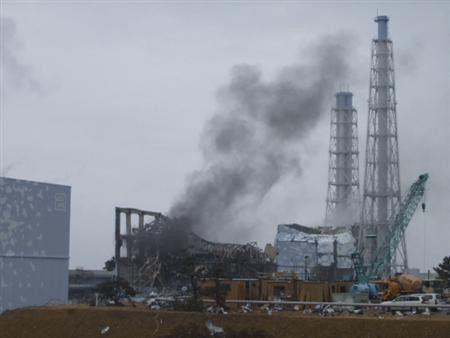IAEA says situation at Fukushima nuclear plant is 'very serious' (OFFICIAL UPDATE)

Current Situation
The situation at the Fukushima Daiichi plant remains very serious.
The restoration of off-site power continues and lighting is now available in the central control rooms of Units 1, 2 and 3. Also, fresh water is now being injected into the Reactor Pressure Vessels (RPVs) of all three Units.
Radiation measurements in the containment vessels and suppression chambers of Units 1, 2 and 3 continued to decrease. White smoke continued to be emitted from Units 1 to 4.
Pressure in the RPV showed a slight increase at Unit 1 and was stable at Units 2 and 3, possibly indicating that there has been no major breach in the pressure vessels.
At Unit 1, the temperature measured at the bottom of the RPV fell slightly to 142 °C. At Unit 2, the temperature at the bottom of the RPV fell to 97 °C from 100 °C reported in the Update provided yesterday. Pumping of water from the turbine hall basement to the condenser is in progress with a view to allowing power restoration activities to continue.
At Unit 3, plans are being made to pump water from the turbine building to the main condenser but the method has not yet been decided. This should reduce the radiation levels in the turbine building and reduce the risk of contamination of workers in the turbine building restoring equipment.
No notable change has been reported in the condition of Unit 4.
Water is still being added to the spent fuel pools of Units 1 to 4 and efforts continue to restore normal cooling functions.
Units 5 and 6 remain in cold shutdown.
We understand that three workers who suffered contamination are still under observation in hospital.
Radiation Monitoring
Dose rates at the Fukushima site continue to trend downwards.
In 28 of the 45 prefectures for which data are available, no deposition of radionuclides was detected in the period 18 to 25 March. In seven of the other 17 prefectures, the estimated daily deposition was less than 500 becquerel per square metre for iodine-131 and less that 100 becquerel per square metre for caesium-137.
On 26 March, the highest values were observed in the prefecture of Yamagata: 7 500 becquerel per square metre for iodine-131 and 1200 becquerel per square metre for caesium-137. In the other prefectures where deposition of iodine-131 was reported, the daily range was from 28 to 860 becquerel per square metre. For caesium-137, the range was from 2.5 to 86 becquerel per square metre.
In the Shinjyuku district of Tokyo, the daily deposition of iodine-131 on 27 March was 220 becquerel per square metre, while for caesium-137 it was 12 becquerel per square metre.
No significant changes were reported in the 45 prefectures in gamma dose rates compared to yesterday. In general, gamma dose-rates tend to decrease due to the decay of short-lived radionuclides such as iodine-131.
Two IAEA teams are currently monitoring in Japan. One team made gamma dose-rate measurements in the Tokyo region at 8 locations. Gamma dose-rates measured ranged from 0.08 to 0.15 microsievert per hour, which is within or slightly above the normal background. The second team made additional measurements at distances of 30 to 41 km from the Fukushima nuclear power plant. At these locations, the dose-rates ranged from 0.9 to 17 microsievert per hour. At the same locations, results of beta-gamma contamination measurements ranged from 0.03 to 3.1 Megabecquerel per square metre.
The first results of aerial surveys of gamma dose-rates by the Japanese authorities have been received by the Incident and Emergency Centre. These are being analysed and will be presented when more detailed data have been received.
New data from monitoring of the marine environment, carried out from 24 March, 22:55 UTC to 25 March, 03:32 UTC about 30 km offshore, show a decrease in both caesium-137 and iodine 131. The contamination at these locations is influenced by aerial deposition of fallout as well as by the migration of contaminated seawater from the discharge points at the reactor. The measured radiation doses rates above the sea remain consistently low (between 0.04 and 0.1 microsievert per hour). The first results of model predictions received from the SIROCCO Group at the University of Toulouse are being assessed.
Recommendations relating to the restriction of drinking water consumption, based on measured concentrations of iodine-131, remain in place in seven locations (in one location for both adults and infants, and in six locations for infants).
As far as food contamination is concerned, samples taken from 23 to 25 March in five prefectures showed iodine-131 in unprocessed raw milk, but the levels were far below the regulation values set by the Japanese authorities. Caesium-137 was also detected in samples of unprocessed raw milk taken on 23 March in Chiba prefecture, but at levels far below the Japanese regulation values. Caesium-137 was not detected in any of the samples taken from 24-25 March in the other four prefectures.
Based on samples taken on 22 and 24-25 March, three prefectures (Chiba, Ibaraki and Tochigi) reported iodine-131 in celery, parsley, spinach and other leafy vegetables above the regulation values set by the Japanese authorities. Caesium-137 was also detected above the regulation values in one sample of spinach taken on 24 March in Tochigi prefecture, but in the remaining two prefectures, the results were below regulation values.
The Joint FAO/IAEA Food Safety Assessment Team arrived in Tokyo on Saturday. It will meet regulatory officials in various prefectures where food contamination has been detected. The team left for Fukushima early today. The Mission will assist and provide advice on sampling protocols, analytical procedures, data collected to date and actions taken by the Japanese authorities for the control of contaminated foods.
© Copyright IBTimes 2024. All rights reserved.





















